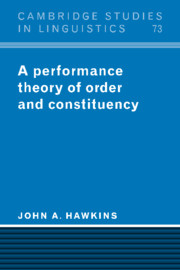Book contents
- Frontmatter
- Contents
- Preface
- Acknowledgments
- List of abbreviations
- 1 Introduction
- 2 The grammaticalization of processing principles
- 3 Early immediate constituents
- 4 Testing EIC's performance predictions
- 5 Testing EIC's grammatical predictions
- 6 Grammaticalized node construction
- 7 Conclusions
- Envoi
- Notes
- References
- Index of names
- Index of languages
- Subject index
4 - Testing EIC's performance predictions
Published online by Cambridge University Press: 18 September 2009
- Frontmatter
- Contents
- Preface
- Acknowledgments
- List of abbreviations
- 1 Introduction
- 2 The grammaticalization of processing principles
- 3 Early immediate constituents
- 4 Testing EIC's performance predictions
- 5 Testing EIC's grammatical predictions
- 6 Grammaticalized node construction
- 7 Conclusions
- Envoi
- Notes
- References
- Index of names
- Index of languages
- Subject index
Summary
In this chapter I shall test the predictions made by EIC for language performance formulated in ch. 3.5. Some preliminary evidence taken from the published literature and involving psycholinguistic experiments, acceptability intuitions, and text frequency counts has already been summarized in ch. 3.3. This evidence did not test EIC directly, however, and was limited in the range of languages considered, just English and Japanese. In this chapter performance data will be considered from the following ten languages: English, German, Greek, Polish, Rumanian; Finnish, Hungarian; Turkish; Japanese and Korean. These languages are typologically diverse and exemplify all the structural possibilities set out in table 3.2. They also represent four distinct genetic stocks (in the classification of Ruhlen 1991: 380): the first five are Indo-European and cover four subfamilies (Germanic, Greek, Slavic, and Romance); Finnish and Hungarian are from the Finno-Ugric branch of Uralic; Turkish is from the Turkic branch of Altaic; and Japanese and Korean belong to the Japanese-Korean-Ainu grouping which Ruhlen now considers separate from Altaic. These languages exhibit considerable freedom of word order, though they also have many grammaticalized orders as well, especially English.
The EIC was explicitly tested on nine of these languages (all but Greek), both by myself and by collaborators at the University of Southern California and in the Constituent Order Group of the European Science Foundation Programme in Language Typology.
- Type
- Chapter
- Information
- A Performance Theory of Order and Constituency , pp. 121 - 249Publisher: Cambridge University PressPrint publication year: 1995



